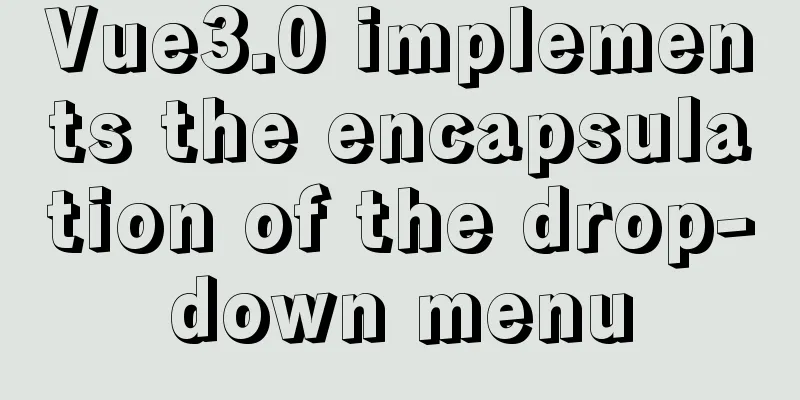5 super useful open source Docker tools highly recommended

IntroductionThe Docker community has created many open source tools that help us handle a variety of use cases. In this article, the author recommends 5 of the most useful Docker tools, namely Watchtower (automatically updating Docker containers), docker-gc (garbage collection for containers and images), docker-slim (container slimming), rocker: breaking through the limitations of Dockerfile, and ctop (container-like top-level interface). The Docker community has created many open source tools that can help you with more use cases than you might even imagine. You can find a lot of cool Docker tools on the Internet, most of which are open source and can be found on Github. Over the past two years, I have become quite enthusiastic about Docker and have been using it in most of my development projects. Once you start using Docker, you'll find that it can be used in more scenarios than you initially thought. You'll want Docker to do as much as possible for you, and it won't let you down! The Docker community is very active, with so many useful tools appearing every day, that it can be difficult to keep up with all the innovation happening in the community. To help you out, I have collected some interesting and useful Docker tools that I use in my daily work, which improve my work efficiency and reduce the work that I would otherwise have to do manually. watchtower (automatically updates Docker containers)Watchtower monitors running containers and watches for changes to the images from which they were originally started. When Watchtower detects that an image has changed, it automatically restarts the corresponding container using the new image. I wanted to try out the latest build image in my local development environment, so I used it. Watchtower itself is packaged as a Docker image, so you can run it like any other container. To run Watchtower, you need to execute the following command: docker run -d --name watchtower --rm -v /var/run/docker.sock:/var/run/docker.sock v2tec/watchtower --interval 3 In the command above, we started the Watchtower container with a mount file /var/run/docker.sock. This is necessary so that Watchtower can interact with the Docker daemon API. We pass 30 seconds to the interval option interval. This option defines the polling interval for Watchtower. Watchtower supports more options, you can use them as described in the documentation. We will now start a container that Watchtower can monitor. docker run -p 4000:80 --name friendlyhello shekhargulati/friendlyhello:latest Now Watchtower will begin gently monitoring the friendlyhello container. When I push a new image to Docker Hub, Watchtower will detect a new image available in subsequent runs. It will gracefully stop that container and start the container using this new image. It will pass the options we passed previously to the run command. In other words, the container will still start using the 4000:80 published ports. By default, Watchtower will poll the Docker Hub registry for updated images. Watchtower can be configured to poll a private registry by passing the registry credentials in the environment variables REPO_USER and REPO_PASS. To learn more about Watchtower, I recommend reading the Watchtower documentation. https://github.com/v2tec/watchtower/blob/master/README.md GitHub address: https://github.com/v2tec/watchtower docker-gc (garbage collection for containers and images)The docker-gc tool helps you clean up your Docker host by removing unneeded containers and images. It removes all containers that are older than one hour. Additionally, it removes images that do not belong to any leftover containers. You can use docker-gc as a script and as a container. We will run docker-gc as a container. To use docker-gc to find all containers and images that can be deleted, the command is as follows: docker run --rm -v /var/run/docker.sock:/var/run/docker.sock -e DRY RUN=1 spotify/docker-gc In the above command, we load the docker.sock file so that docker-gc can interact with the Docker API. We pass an environment variable DRY_RUN=1 to find the containers and images that will be deleted. If this parameter is not provided, docker-gc will delete all containers and images. It is best to confirm in advance what docker-gc is going to delete. The output of the above command is as follows: \[2017-04-28T06:27:24\] \[INFO\] : The following container would have been removed 0c1b3b0972bb792bee508 60c35a4 bc08ba32b527d53eab173d12a15c28deb931/vibrant_ yonath\[2017-04-28T06:27:24\] \[INFO\] : The following container would have been removed 2a72d41e4b25e2782f7844e188643e395650a9ecca660e7a0dc2b7989e5acc28 /friendlyhello_ web\[2017-04-28T06:27:24\] \[INFO\] : The following image would have been removed sha256:00f017a8c2a6e1 fe2f fd05c281 f27d069d2a99323a8cd514dd35f228ba26d2ff\[busybox: latest\]\[2017-04-28T06:27:24\] \[ INFO\] : The following image would have been removed sha256 :4a323b466a5ac4ce6524 8dd970b538922c54e535700cafe9448b52a3094483ea\[hello-world:latest\]\[2017-04-28T06:27:24\] \[INFO\] : The following image would have been removed sha256:4a323b4 66a5ac4ce65248dd970b538922c54e535700cafe9448b52a3094483ea\[python:2.7-slim\] If you agree with the docker-gc cleanup solution, you can run docker-gc again without using DRY_RUN to perform the cleanup operation. docker run --rm -v /var/run/docker.sock:/var/run/docker.sock spotify/docker-gc docker-gc also supports some other options. I recommend you read the docker-gc documentation for more information: https://github.com/spotify/docker-gc/blob/master/README.md GitHub address: https://github.com/spotify/docker-gc docker-slim (the magic slimming pill for containers)If you are worried about the size of your Docker image, docker-slim can help you solve the problem. The docker-slim tool uses static and dynamic analysis methods to slim down your bloated images. To use docker-slim, you can download the binary installation package for Linux or Mac from Github. After successfully downloading, add it to your system PATH variable. For example purposes, I created a Docker image named friendlyhello according to the official Docker documentation. The image size is 194MB (as shown below):
You can see that for a simple application we have to download 194 MB of data. Let's use docker-slim to see how much fat it can cut. docker-slim build --http-probe friendlyhello The docker-slim tool performs a series of checks and measurements on the fat image and ultimately creates a thin version of the image. Let's take a look at the size of this weight loss.
As you can see, the image size is reduced to 24.9 MB. You can start this container and it will run in the same way. The docker-slim tool supports Java, Python, Ruby, and Node.js applications. Try it yourself and see how much you can lose. In my personal projects, I find it works well in most cases. You can learn more about docker-slim from its documentation: https://github.com/docker-slim/docker-slim/blob/master/README.md GitHub address: https://github.com/docker-slim/docker-slim rocker (breaking the limitations of Dockerfile)Most developers who use Docker use a Dockerfile to build an image. A Dockerfile is a declarative way to define all the commands that a user can call on the command line to assemble an image. Rocker (https://github.com/grammarly/rocker) adds new instructions to the Dockerfile instruction set. Grammarly created Rocker to solve the problems they encountered with the Dockerfile format. The Grammarly team wrote an in-depth blog explaining why they created it. I recommend you to read it to get a better understanding of Rocker. They highlighted two issues in their blog post: The size of the Docker image. Slow build speed. The blog also mentions some new commands added by Rocker. Refer to the Rocker documentation for all the commands supported by Rocker: https://github.com/grammarly/rocker/blob/master/README.md MOUNT is used to share volumes between builds so that they can be reused by dependency management tools. There is already a FROM instruction in the Dockerfile. Rocker allows us to add more than one FROM instruction. This means you can create multiple images from a single Rockerfile. The first batch of instructions is used to build all dependencies of the product; the second batch of instructions is used to build the product; this can greatly reduce the image size. TAGs are used to identify images at different stages of the build, which means you don't have to manually tag each image. PUSH is used to push images to the image repository. ATTACH enables you to run intermediate steps interactively. This is very useful for debugging. To use Rocker, you must first install it on your machine. For Mac users, it's as simple as running a few brew commands: brew tap grammarly/tap$ brew install grammarly/tap/rocker Once installed, you can build images using Rocker by passing it a Rockerfile:
FROM python:2.7-slimWORKDIR /appADD ./appRUN pip install -r requirements.txtEXPOSE 80ENV NAME WorldCMD \["python","app.Py"\]TAG shekhargulati/friendlyhello:{{ .VERSION }}PUSH shekhargulati/friendlyhello:{{ .VERSION }}To build an image and push it to Docker Hub, you can run the following command: rocker d build --push -var VERSION-1.0 GitHub address: https://github.com/grammarly/rocker ctop (container-like top-level interface)ctop is a tool I recently started using that provides a real-time view of metrics across multiple containers. If you are a Mac user, you can install it using brew as follows: brew install ctop Once the installation is complete, you can start using ctop. Now, you just need to configure the DOCKER_HOST environment variable. You can run the ctop command to view the status of all containers.
If you only want to view running containers, you can use the ctop -a command. ctop is a simple tool that is useful for understanding the containers running on your host. You can learn more about it in the ctop documentation: github.com/bcicen/ctop/blob/master/README.md GitHub address: https://github.com/bcicen/ctop This concludes this article about 5 highly recommended open source Docker tools that are super useful. For more relevant open source Docker tools content, please search for previous articles on 123WORDPRESS.COM or continue to browse the related articles below. I hope everyone will support 123WORDPRESS.COM in the future! You may also be interested in:
|
<<: CSS makes tips boxes, bubble boxes, and triangles
>>: MYSQL slow query and log example explanation
Recommend
Some conclusions on the design of portal website focus pictures
Focus images are a way of presenting content that ...
Installing the ping tool in a container built by Docker
Because the Base images pulled by Docker, such as...
VMware virtual machine installation CentOS 8 (1905) system tutorial diagram
The world-famous virtual machine software VMware-...
Summary of several key points about mysql init_connect
The role of init_connect init_connect is usually ...
How to correctly modify the ROOT password in MySql8.0 and above versions
Deployment environment: Installation version red ...
Common problems and solutions during MySQL MGR construction
Table of contents 01 Common Faults 1 02 Common Fa...
CSS3 uses var() and calc() functions to achieve animation effects
Preview knowledge points. Animation Frames Backgr...
Detailed explanation of using CSS3's var() to change scss variable values at runtime
var() Introduction and Usage Details (MDN) IE is ...
Implementation code for partial refresh of HTML page
Event response refresh: refresh only when request...
Mysql transaction isolation level principle example analysis
introduction You must have encountered this in an...
Using react-virtualized to implement a long list of images with dynamic height
Table of contents Problems encountered during dev...
4 flexible Scss compilation output styles
Many people have been told how to compile from th...
mysql5.7.21.zip installation tutorial
The detailed installation process of mysql5.7.21 ...
Vue routing lazy loading details
Table of contents 1. What is lazy loading of rout...
How to dynamically modify the replication filter in mysql
MySQL dynamically modify replication filters Let ...












